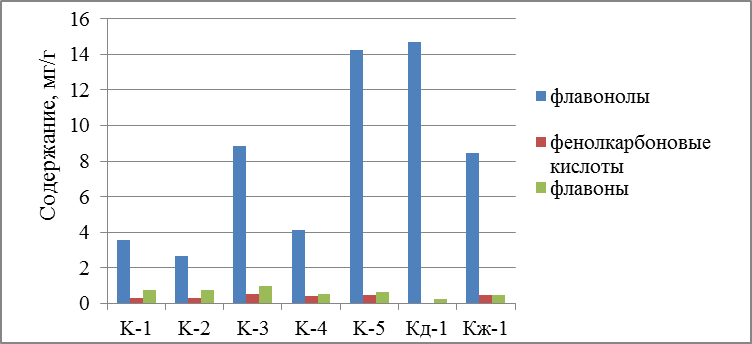THE COMPOSITION AND CONTENT OF PHENOLIC COMPOUNDS IN THE LEAVES OF A POTENTIALLY INVA-SIVE SPECIES PHYSOCARPUS OPULIFOLIUS (L.) MAXIM. AND ITS ORNAMENTAL CULTIVARS
UDC 577.13:581.524.2.
Abstract
The expansion of alien plant species in natural communities is now taking a global scale. Since most invasive plants have economically valuable properties, many researchers agree that these plants must be used as new sources of biological resources. The composition and content of biologically active compounds were studied in the leaves of potentially invasive species of Novosibirsk – Physocarpus opulifolius (L.) Maxim. and its ornamental cultivars Ph. opulifolius ‘Diabolo’, Ph. opulifolius ‘Luteus’ by the method of High-Performance Liquid Chromatography. For the first time an analysis of phenolic profiles of introduced, self-sown and cultivated Ph. opulifolius plants has been performed. Presence of 22 phenolic compounds represented by several groups of substances with predominating flavanols (hyperoside, rutin, astragalin and quercetin) has been established. Avicularin has been only revealed in the leaves of cultivars. The sum of identified flavonols greatly varies in different samples, the highest content is in the cultivar Ph. opulifolius ‘Diabolo’ (14.68 mg/g) and self-sown plants of Ph. opulifolius (14.22 mg/g). The content of the sum of identified flavons (vitexin, isovitexin, baicalin) and phenolic acid (сhlorogenic and caffeic acids) is almost the same in all Ph. opulifolius samples under study. The data obtained will allow to widen the idea of the resource potential of the aggressive invasive species and its ornamental cultivars in the secondary areal.
Downloads
Metrics
References
Callaway R.M., Aschehoug E.T. Science, 2000, vol. 290, pp. 521–523. DOI: 10.1126/science.290.5491.521.
Richardson D.M., Pyšek P., Rejmánek M., Barbour M.G., Panetta F.D., West C.J. Diversity and distribution, 2000, vol. 6, pp. 93–107.
Xu S.Z., Li Z.Y., Jin X.H. Molecular ecology resources, 2018, vol. 18, no. 1, pp. 128–136. DOI: 10.1111/1755-0998.12715.
Vinogradova Yu.K., Mayorov S.R., Khorun L.V. Chernaya kniga flory Sredney Rossii (Chuzherodnyye vidy rasteniy v ekosistemakh Sredney Rossii). [Black Book of Flora of Central Russia (Alien plant species in ecosystems of Central Russia)]. Moscow, 2010, 494 p. (in Russ.).
Vinogradova Yu.K., Kuklina A.G. Resursnyy potentsial invazionnykh vidov rasteniy. Vozmozhnosti ispol'zovaniya chu-zherodnykh vidov. [Resource potential of invasive plant species. Opportunities for the use of alien species]. Moscow, 2012, 186 p. (in Russ.).
Shelepova O.V., Kuklina A.G., Vinogradova Yu.K. Nauchnyy zhurnal KubGAU, 2015, no. 14(10), pp. 1–16. (in Russ.).
Macel M., de Vos R.C., Jansen J.J., van der Putten W.H., van Dam N.M. Ecology and Evolution, 2014, vol. 4, no. 13, pp. 2777–2786. DOI: 10.1002/ece3.1132.
Wagh V.V., Jain A.K. South African Journal of Botany, 2018, vol. 114, pp. 171–180. DOI: 10.1016/j.sajb.2017.11.008.
Belanova A.P., Ebel' A.L., Lyakh Ye.M. Vestnik Altayskogo gosudarstvennogo agrarnogo universiteta, 2017, no. 3, pp. 87–92. (in Russ.).
Chindyaeva L.N., Belanova A.P., Kiseleva T.I. Russian Journal of Biological Invasions, 2018, vol. 9, no. 3, pp. 273–285. DOI: 10.1134/S2075111718030025.
Sarker S.D., Whiting P, Šik V., Dinan L. Phytochemistry, 1999, vol. 50, no. 7, pp. 1123–1128. DOI: 10.1016/S0031-9422(98)00653-0.
Safronova I.A., Yatsyuk V.Ya., Kuz'minova A.V. Kurskiy nauchno-prakticheskiy vestnik «Chelovek i yego zdorov'ye», 2009, no. 4, pp. 131–139. (in Russ.).
Safronova I.A., Yatsyuk V.Ya., Kuz'minova A.V. Nauchnyye vedomosti BelGU. Seriya: Meditsina. Farmatsiya, 2012, no. 10 (129), pp. 57–59. (in Russ.).
Kim Y.K., Yoon S.K., Ryu S.Y. Plant. Med., 2000, vol. 66, no. 05, pp. 485–486.
Oh S.H. Korean J. Pl. Taxon., 2015, vol. 45, no. 4, pp. 332–352. DOI: 10.11110/kjpt.2015.45.4.332.
Vysochina G.I. Fenol'nyye soyedineniya v sistematike i filogenii semeystva grechishnykh. [Phenolic compounds in the taxonomy and phylogeny of the buckwheat family]. Novosibirsk, 2004, 240 p. (in Russ.).
Khramova Ye.P., Komarevtseva Ye.K. Rastitel'nyye resursy, 2008, vol. 44, no. 3, pp. 96–102. (in Russ.).
van Beek T.A. Journal of Chromatography A, 2002, vol. 967, no. 1, pp. 21–55. DOI: 10.1016/S0021-9673(02)00172-3.
Kostikova V.A., Khramova Ye.P., Syyeva S.Ya. Rastitel'nyye resursy, 2018, vol. 54, no. 3, pp. 409–419. (in Russ.).
Zaprometov M.N. Fenol'nyye soyedineniya: rasprostraneniye, metabolizm i funktsii v rasteniyakh. [Phenolic com-pounds: distribution, metabolism and functions in plants]. Moscow, 1994, 240 p. (in Russ.).
Korul'kin D.Yu., Abilov Zh.A., Muzychkina R.A., Tolstikov G.A. Prirodnyye flavonoidy. [Natural flavonoids]. Novo-sibirsk, 2007, 232 p. (in Russ.).

Copyright (c) 2020 chemistry of plant raw material

This work is licensed under a Creative Commons Attribution 4.0 International License.

This work is licensed under a Creative Commons Attribution 4.0 International License.
The authors, which are published in this journal, agree to the following conditions:
1. Authors retain the copyright to the work and transfer to the journal the right of the first publication along with the work, at the same time licensing it under the terms of the Creative Commons Attribution License, which allows others to distribute this work with the obligatory indication of the authorship of this work and a link to the original publication in this journal .
2. The authors retain the right to enter into separate, additional contractual agreements for the non-exclusive distribution of the version of the work published by this journal (for example, to place it in the university depository or to publish it in a book), with reference to the original publication in this journal.
3. Authors are allowed to post their work on the Internet (for example, in a university repository or on their personal website) before and during the review process of this journal, as this may lead to a productive discussion, as well as more links to this published work.











